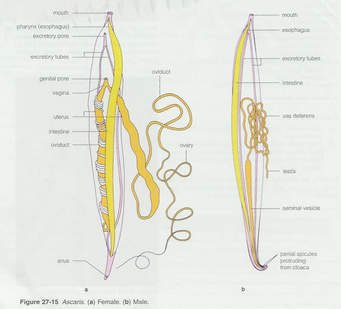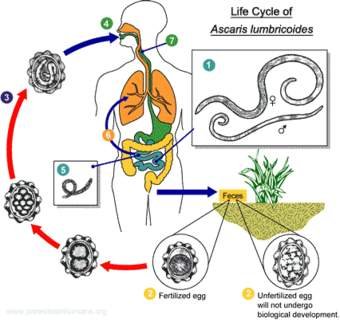
Ascaris lumbricoides is an example of intestinal parasite and is also a round worm.It is the largest intestinal parasite that infect human.The adult worm lives in the small intestine and grows to a length of more than 30cm.Human is the only natural host and reservoir of the infection, and the infection occurs worldwide.The number of the infected person is estimated to be more than 2billion individuals and the main epidermic region with prevalence rate of approximately 19% - 20% includes countries in south eastern Asia and of course Africa and America.
MORPHOLOGY

The adult round worm resembles the earthworm, its anterior end is tinier than the posterior end and freshly excreted worms is yellowish pink in colour and it gradually changes to white.The worm is sexually dimorphic,the adult male is as long as 15 - 30cm in length and 3 – 4mm in diameter.The tail is also curved.The adult female is about 20 – 40cm in length, 2 – 6mm in diameter and the tail is straight.
Ascaris egg is round or oval and its about 60 or 40mm in size with a thick brown shell and rough surface.It is the infective form of the parasite.There are two types of eggs;Fertilized and Unfertilized.
LIFE CYCLE OF ASCARIS
This life cycle is completed in a single host which is the human.The adult worm lives in the small intestine and there are five stages in the life cycle.
STAGE 1: RELEASE OF EGG IN FEACES
Sexually matured female produces as many as 200,000 eggs per day which are shield along with feaces in its ineffective form (unembrayonated form).
STAGE 2: EMBRAYONATION
Embrayonation occurs in the soil at optimum temperature between 20 – 25°C with the sufficient moisture and oxygen.An effective larva develops within the egg in about 3 – 6 weeks.
STAGE 3: HUMAN INFECTION AND LIBERATION OF THE LARVA
Human get infected by ingestion of the embrayonated egg that they can be present in food and water.Within the embrayonated state,the first larva stage develops into the second.The second larva stage is stimulated to hatch out by the presence of alkaline pH in the small intestine and solubilization of its outer layer by bile.
STAGE 4: MIGRATION OF THE LARVA THROUGH THE LUNGS
The hatched out larva penetrate the intestinal wall/layer and is carried to the liver through circulation process.Then it travels through the blood to the heart and then lungs by pulmonary circulation within 4 – 7days of the infection.The larva that is in the lungs becomes enlarged and breaks into the Aveola.
STAGE 5: RE-ENTRY TO THE STOMACH AND SMALL INTESTINE
From the Aveola the larva then passes up through the bronchi into the trachea and is then swallowed.The larva passes down the oesophagus to the stomach and then reaches the small intestine once again.The small intestine is the normal habitat of ascaris and within the intestine the parasite matures to the adult worm,sexual maturation occurs within 6 – 10weeks and the female egg that develops is discharged.The life span of the ascaris parasite is 12 – 18months.
Thanks dolamu.
Authors get paid when people like you upvote their post.
If you enjoyed what you read here, create your account today and start earning FREE STEEM!
If you enjoyed what you read here, create your account today and start earning FREE STEEM!
Hi! I am a robot. I just upvoted you! I found similar content that readers might be interested in:
http://www.onlinebiologynotes.com/ascaris-lumbricoides-morphology-life-cycle-pathogenesis-lab-diagnosis-treatment/
Downvoting a post can decrease pending rewards and make it less visible. Common reasons:
Submit
thanks
Downvoting a post can decrease pending rewards and make it less visible. Common reasons:
Submit